Helichrysum
The genus Helichrysum /hɛlɪˈkraɪsəm/ consists of an estimated 600 species of flowering plants in the sunflower family (Asteraceae). The type species is Helichrysum orientale. The name is derived from the Greek words ἑλίσσω (helisso, to turn around) and χρῡσός (chrysos, gold).
| Strawflower | |
|---|---|
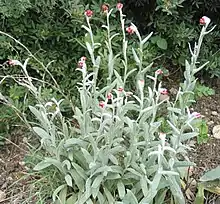 | |
| Red Everlasting (Helichrysum sanguineum) | |
| Scientific classification | |
| Kingdom: | |
| (unranked): | |
| (unranked): | |
| (unranked): | |
| Order: | |
| Family: | |
| Subfamily: | |
| Tribe: | |
| Genus: | Helichrysum Mill., 1754 |
| Species | |
|
See text | |
It occurs in Africa (with 244 species in South Africa), Madagascar, Australasia and Eurasia. The plants may be annuals, herbaceous perennials or shrubs, growing to a height of 60–90 cm (24–35 inches). The genus was a wastebasket taxon, and many of its members have been reclassified in smaller genera, most notably the Everlastings, now in the genus Xerochrysum.
Their leaves are oblong to lanceolate. They are flat and pubescent on both sides. The bristles of the pappus are scabrous, barbellate, or plumose.
The receptacle (base of the flower head) is often smooth, with a fringed margin, or honey-combed, and resemble daisies. They may be in almost all colors, except blue. There are many capitula and generally flat-topped corymbs or panicles. The corolla lobes show glandular hairs at the abaxial surface.
Helichrysum species are used as food plants by the larvae of some Lepidoptera species including the bucculaticid leaf-miners Bucculatrix gnaphaliella (which feeds exclusively on Helichrysum arenarium) and Bucculatrix helichrysella (feeds exclusively on H. italicum) and the Coleophora case-bearers C. caelebipennella, C. gnaphalii (feeds exclusively on H arenarium) and C. helichrysiella (feeds exclusively on H. italicum).
Species
Hilliard (1983) divided this large and heterogeneous genus in 30 morphological groups. But this genus is controversial and is considered by many as an artificial genus. The taxonomy of the large polymorphic and probably polyphyletic genus Helichrysum is complex and not yet satisfactorily resolved. Several Australian species, such as H. acuminatum and H. bracteatum, have been reclassified in the genus Xerochrysum in 1991, resp. as X. subundulatum and X. bracteatum. In 1989, misaligned species of Helichrysum were reclassified in Syncarpha. Species included in Pseudognaphalium, Anaphalis, Achyrocline and Humeocline are probably congeneric with Helichrysum.[1]
- Established species include
- Helichrysum abrotaniforme
- Helichrysum aciculare
- Helichrysum acuminatum
- Helichrysum acutatum : Sticky everlasting
- Helichrysum adenocarpum : Pink everlasting, red everlasting
- Helichrysum adenophorum
- Helichrysum adnatum
- Helichrysum adonidiforme
- Helichrysum aggregatum
- Helichrysum alatum
- Helichrysum albicans
- Helichrysum allioides
- Helichrysum alpinum
- Helichrysum ambiguum
- Helichrysum amorginum
- Helichrysum angustifolium : Curry plant
- Helichrysum angustum
- Helichrysum anomalum
- Helichrysum antennaria
- Helichrysum anthemoides
- Helichrysum apiculatum
- Helichrysum appendiculatum : Sheep's ears everlasting
- Helichrysum arachnoides
- Helichrysum arenarium : Dwarf everlasting
- Helichrysum arenarium ssp. arenarium
- Helichrysum arenarium ssp. ponticum
- Helichrysum argentissimum
- Helichrysum argyroglottis
- Helichrysum argyrolepis
- Helichrysum argyrophyllum
- Helichrysum argyrosphaerum : Wild everlasting
- Helichrysum asteroides
- Helichrysum aureonitens : Golden everlasting
- Helichrysum aureum : Yellow everlasting
- Helichrysum auriceps
- Helichrysum ayersii
- Helichrysum baccharoides
- Helichrysum backhousei
- Helichrysum balfourii
- Helichrysum banksii
- Helichrysum basedowii
- Helichrysum beckleri
- Helichrysum biafranum
- Helichrysum bicolor
- Helichrysum bidwillii
- Helichrysum bilobum
- Helichrysum blackallii
- Helichrysum blandowskianum
- Helichrysum boormanii
- Helichrysum brachyrhynchum
- Helichrysum buftonii
- Helichrysum bupthalmoides
- Helichrysum caespititium
- Helichrysum calvertianum
- Helichrysum cameroonense
- Helichrysum candolleanum
- Helichrysum cassinioides
- Helichrysum cassiope
- Helichrysum cephaloideum
- Helichrysum cerastioides
- Helichrysum chionosphaerum : Dwarf everlasting
- Helichrysum chlorochrysum
- Helichrysum cinereum
- Helichrysum cladochaetum
- Helichrysum cochleariforme : Gold-and-silver
- Helichrysum collinum
- Helichrysum conditum
- Helichrysum confertifolium
- Helichrysum cooperi : Yellow everlasting
- Helichrysum cordatum
- Helichrysum coriaceum
- Helichrysum costatifructum
- Helichrysum crispum
- Helichrysum cunninghamii
- Helichrysum cylindrifolium
- Helichrysum cymosum
- Helichrysum dasyanthum
- Helichrysum dasymallum
- Helichrysum davenportii
- Helichrysum decorum
- Helichrysum diosmifolium (synonym of Ozothamnus diosmifolius)
- Helichrysum diotophyllum
- Helichrysum doerfleri
- Helichrysum ecklonis : Ecklon's everlasting
- Helichrysum epapposum
- Helichrysum eremaeum
- Helichrysum eriocephalum
- Helichrysum erosum
- Helichrysum expansifolium
- Helichrysum felinum : Strawberry everlasting
- Helichrysum ferrugineum
- Helichrysum filifolium
- Helichrysum flavissimum
- Helichrysum foetidum : Polecat strawflower, stinking strawflower
- Helichrysum formosissimum
- Helichrysum frigidum
- Helichrysum gatesii
- Helichrysum gerberaefolium[2]
- Helichrysum gilesii
- Helichrysum glomeratum
- Helichrysum glumaceum
- Helichrysum glutinosum
- Helichrysum gracilescens
- Helichrysum grandiflorum
- Helichrysum graveolens
- Helichrysum grayi
- Helichrysum griseum
- Helichrysum gymnocephalum
- Helichrysum gymnocomum
- Helichrysum harveyanum
- Helichrysum hebelepis
- Helichrysum heldreichii
- Helichrysum herbaceum : Monkey-tail everlasting
- Helichrysum hirtoviscosum
- Helichrysum humboldtianum
- Helichrysum hypoleucum
- Helichrysum incanum
- Helichrysum indicum
- Helichrysum inornatum
- Helichrysum insigne
- Helichrysum involucratum
- Helichrysum italicum : Curry plant
- Helichrysum italicum ssp. italicum
- Helichrysum italicum ssp. microphyllum
- Helichrysum italicum ssp. serotinum
- Helichrysum kempei
- Helichrysum kraussii : Straw everlasting
- Helichrysum krookii
- Helichrysum lanuginosum
- Helichrysum lawrencella
- Helichrysum ledifolium
- Helichrysum lepidophyllum
- Helichrysum leptolepis
- Helichrysum leucocephalum
- Helichrysum leucopsideum
- Helichrysum lindleyi
- Helichrysum lindsayanum
- Helichrysum lucidum
- Helichrysum lucilioides
- Helichrysum luteoalbum
- Helichrysum lycopodioides
- Helichrysum macivorii
- Helichrysum maidenii
- Helichrysum manglesii
- Helichrysum mannii
- Helichrysum melanacme
- Helichrysum melitense
- Helichrysum mellorianum
- Helichrusum michaelium
- Helichrysum milfordiae
- Helichrysum milliganii
- Helichrysum mimetes : Curry everlasting
- Helichrysum moeserianum
- Helichrysum monochaetum
- Helichrysum mundtii
- Helichrysum nanum
- Helichrysum newcastlianum
- Helichrysum nimmoanum
- Helichrysum niveum
- Helichrysum nudifolium : Hottentot's tea
- Helichrysum obcordatum
- Helichrysum obovatum
- Helichrysum obtusifolium
- Helichrysum occidentale
- Helichrysum odoratissimum
- Helichrysum oldfieldii
- Helichrysum oligochaetum
- Helichrysum oreophilum
- Helichrysum orientale (type species)
- Helichrysum oxylepis
- Helichrysum pallidum
- Helichrysum panduratum
- Helichrysum pandurifolium
- Helichrysum paralium
- Helichrysum patulum : Honey everlasting
- Helichrysum paulayanum
- Helichrysum pedunculatum
- Helichrysum petiolare : Licorice plant
- Helichrysum pholidotum
- Helichrysum pilosellum
- Helichrysum pleurandroides
- Helichrysum plicatum
- Helichrysum podolepidium
- Helichrysum populifolium : Poplar helichrysum
- Helichrysum porrectum
- Helichrysum pseudoferrugineum
- Helichrysum pseudoturbinatum
- Helichrysum pterochaetum
- Helichrysum pumilio
- Helichrysum purpurascens
- Helichrysum puteale
- Helichrysum ramosissimum
- Helichrysum readeri
- Helichrysum reticulatum
- Helichrysum reflexum : White everlasting
- Helichrysum retortum
- Helichrysum revolutum
- Helichrysum robustum
- Helichrysum rogersianum
- Helichrysum roseum
- Helichrysum rosulatum
- Helichrysum rosum
- Helichrysum ruderale
- Helichrysum rufescens
- Helichrysum rugulosum
- Helichrysum rupestre
- Helichrysum sanguineum : Red everlasting
- Helichrysum sarcodes
- Helichrysum saxatile
- Helichrysum saxatile ssp. errerae
- Helichrysum saxatile ssp. saxatile
- Helichrysum scitulum
- Helichrysum scutellifolium
- Helichrysum secundiflorum
- Helichrysum selaginoides
- Helichrysum semiamplexicaule
- Helichrysum semicalvum
- Helichrysum semifertile
- Helichrysum semipapposum
- Helichrysum setosum : Yellow everlasting
- Helichrysum sibthorpii
- Helichrysum sonderi
- Helichrysum spiceri
- Helichrysum spiralepis
- Helichrysum sphaerocephalum
- Helichrysum splendidum : Cape gold
- Helichrysum stellatum
- Helichrysum stipitatum
- Helichrysum stirlingii
- Helichrysum stoechas : Shrubby everlasting
- Helichrysum stoechas ssp. barrelieri
- Helichrysum stoechas ssp. stoechas
- Helichrysum stoveae
- Helichrysum subulifolium
- Helichrysum suffruticosum
- Helichrysum sulcaticaule
- Helichrysum superbum
- Helichrysum sutherlandii
- Helichrysum tasmanicum
- Helichrysum teretifolium
- Helichrysum thianschanicum
- Helichrysum thomsonii
- Helichrysum trilineatum
- Helichrysum tuckeri
- Helichrysum turbinatum
- Helichrysum umbraculigerum
- Helichrysum vagans
- Helichrysum versicolor
- Helichrysum viscosum
- Helichrysum waitzioides
- Helichrysum whitei
Helichrysum stoechas is similar to the Helichrysum arenarium, but the leaves are all linear, with rolled under edges. It is found in western France on dunes near the sea.
- New species
In 2004, A. Miller identified five potentially new species that have not yet been published but were included in the IUCN Red List data, given their restricted range in Yemen. They are as follows:
- Helichrysum sp. nov. A - Its natural habitat is rocky areas. It was given a status of "Vulnerable" by the IUCN.[3]
- Helichrysum sp. nov. B - Its natural habitats are subtropical or tropical dry shrubland and rocky areas. It was given a status of "Vulnerable".[4]
- Helichrysum sp. nov. C - Its natural habitat is rocky areas. It is threatened by habitat loss. It was given a status of "Endangered".[5]
- Helichrysum sp. nov. D - Its natural habitat is rocky areas. It was given a status of "Endangered".[6]
- Helichrysum sp. nov. E - Its natural habitat is rocky areas. It was given a status of "Data deficient".[7]
Uses
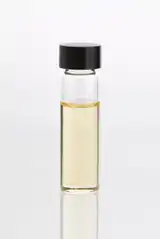
Several species are grown as ornamental plants, and for dried flowers. When cut young and dried, the open flowers and stalks preserve their colour and shape for long periods.
Helichrysum italicum (synonym Helichrysum angustifolium) is steam distilled to produce a yellow-reddish essential oil popular in fragrance for its unique scent, best described as herbaceous, sweet, and honey-like. The epithet angustifolium means narrow leaved. It is commonly misspelled as augustifolium.[8]
Gallery
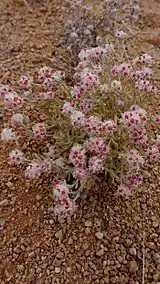
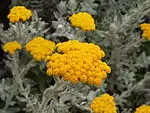 Helichrysum moeserianum in De Hoop N.R., South Africa
Helichrysum moeserianum in De Hoop N.R., South Africa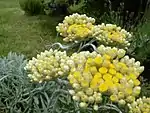
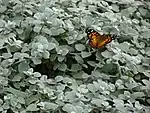 Helichrysum petiolare, Licorice Plant
Helichrysum petiolare, Licorice Plant Helichrysum roseo-niveum in Namibia
Helichrysum roseo-niveum in Namibia Helichrysum setosum
Helichrysum setosum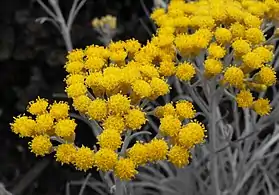 Helichrysum thianschanicum 'Icicles' on display at the San Diego County Fair, CA, USA
Helichrysum thianschanicum 'Icicles' on display at the San Diego County Fair, CA, USA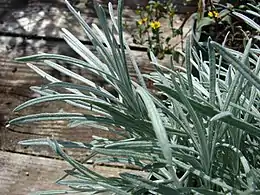 Helichrysum thianschanicum (Icicles leaves) at nursery on Maui
Helichrysum thianschanicum (Icicles leaves) at nursery on Maui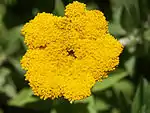 Helichrysum umbraculigerum
Helichrysum umbraculigerum
Notes
- Galbany-Casals, M. et al. 2014 Taxon, 63:608-624. Phylogenetic relationships in Helichrysum (Compositae: Gnaphalieae) and related genera: Incongruence between nuclear and plastid phylogenies, biogeographic and morphological patterns, and implications for generic delimitation
- Bussmann, R. W., et al. (2006). Plant use of the Maasai of Sekenani Valley, Maasai Mara, Kenya. J Ethnobiol Ethnomed 2 22.
- Miller, A. 2004. Helichrysum sp. nov. A. 2006 IUCN Red List of Threatened Species. Archived 2014-06-27 at the Wayback Machine Downloaded on 20 July 2007.
- Miller, A. 2004. Helichrysum sp. nov. B. 2006 IUCN Red List of Threatened Species. Archived 2014-06-27 at the Wayback Machine Downloaded on 20 July 2007.
- Miller, A. 2004. Helichrysum sp. nov. C. 2006 IUCN Red List of Threatened Species. Archived 2014-06-27 at the Wayback Machine Downloaded on 20 July 2007.
- Miller, A. 2004. Helichrysum sp. nov. D. 2006 IUCN Red List of Threatened Species. Archived 2014-06-27 at the Wayback Machine Downloaded on 20 July 2007.
- Miller, A. 2004. Helichrysum sp. nov. E. 2006 IUCN Red List of Threatened Species. Archived 2014-06-27 at the Wayback Machine Downloaded on 20 July 2007.
- http://www.floralimages.co.uk/info/botanicallatin.html for more details on botanical naming.
References
- HILLIARD, O. 1983. Flora of Southern Africa, Part 7 Inuleae, Fascicle 2 Gnaphaliinae. Government Printer, Pretoria, South Africa.
- WILSON, P.G. 1992c. The classification of some Australian species currently included in Helipterum and Helichrysum (Asteraceae: Gnaphalieae): part 3 Anemocarpa and Argentipallium, two new genera from Australia. Nuytsia 8: 447–460.
- Mesfin Tadesse & Reilly, T. 1995. 17. A contribution to studies on Helichrysum (Compositae - Gnaphalieae) - a revision of the species of north-east tropical Africa. In: Advances in Compositae Systematics (eds. D.J.H. Hind, C. Jeffrey & G.V. Pope). Royal Botanic Gardens, Kew, pp. 379–450.
External links
| Wikimedia Commons has media related to Helichrysum. |
| Wikispecies has information related to Helichrysum. |
- Xeranthemum annuum photo
- Phylogenetic relationships within this genus
- Helichrysum Essential Oil species
- PHYLOGENY OF SOUTH AFRICAN GNAPHALIEAE (ASTERACEAE)
- Details of botanical naming
- Dressler, S.; Schmidt, M. & Zizka, G. (2014). "Helichrysum". African plants – a Photo Guide. Frankfurt/Main: Forschungsinstitut Senckenberg.